Make a DIY solar oven to help kids to learn about sustainability, solar power and harnessing energy. This is a fun and easy science experiment that also has practical use.
Note: This DIY Solar Oven is a kids activity for experimental purposes only. The oven DOES work but eat your solar-cooked food at your own risk. It’s also important to note that this oven gets HOT so please supervise young children and take care when touching the glass bowl. Use a tea towel or oven mitt for safety.
This kids STEM project was first published in 2017 and has been updated and republished for todays audience
You might also like our DIY speaker from recyclables
We’ve had a super-hot summer this year, apparently the hottest in recorded history. For our location this means more 40ºc+ days than I care to remember (and if you’re from the USA 40ºc = 104ºF).
A hot summer is not all bad though! It’s given us multiple perfect opportunities to test out this completely awesome DIY solar oven we made from a cardboard box.
How does it work?
A solar oven works by catching sunlight using a reflector and reflecting it onto a black surface (we’ve used a black sheet of paper). The black surface transforms the light into heat and the upturned glass bowl traps the heat inside. It heats up just like your car does on a hot summer day.
Solar ovens slow-cook food on a low heat over a longer period of time than conventional ovens but they DO work. You can purchase manufactured solar ovens in different designs like this one from Amazon. They are usually used by people when camping or for dehydrating foods. I researched a number of different solar oven designs and DIY projects before coming up with this version.
How to make a DIY solar oven:
It’s very easy to make a DIY Solar Oven. This one has been created from a repurposed large Amazon book box which was the perfect size for the job, but any box which is large and flat would be a good fit.
You will need:
- A large, flat cardboard box similar to an Amazon book box
- Craft glue
- Aluminium foil
- Duct tape
- A sheet of black paper, or something dark in colour like a black oven tray
- A heat-proof glass bowl or casserole dish
- A thermometer – we have used two thermometers, one inside and one outside the oven to see the difference it made in temperature more clearly. Our dial-style meat thermometer was perfect for inside the oven because it has a large, easily readable face. Our thermometer reads in º C but you can get a similar one with ºF readings on Amazon
- This printable time and temperature chart
- A hot day with minimal cloud cover – ideally the temperature should be 28ºC + (82.4ºF), the hotter the better.
How to:
Step 1 | Change your box to have a single flap as a lid. This can be done by removing three of the flaps leaving only one long flap in place. Stick the removed long flap to the one left in place with staples and duct tape. It doesn’t matter that your single flap is slightly shorter than the width of the box because it is only used as a reflector.
Step 2 | Line the inside of your box and flap with aluminium foil and glue it into place with craft glue. Stick the edges of the foil down around the outside of the box with duct tape.
Step 3| Use the discarded cardboard from the short side flaps to create the legs you will use to prop the lid open. Do this by trimming the legs into thin strips (approx. 2 inches wide) with an angle on one end. Stick the legs on at an angle using duct tape. The flexible duct tape join will enable the legs to fold inside the box when you are packing it away. It will also enable the lid to be set at various different angles to best catch the sun’s rays.
Step 4| Place your sheet of black paper inside the box with an upturned glass bowl on top. Place your thermometer underneath the bowl. If you have a second thermometer put that outside the oven so you can compare the two temperatures.
How to use your DIY solar oven
- Set your DIY solar oven up outside in full sun, with the reflector facing directly at the sun. Monitor how hot it gets inside, when the temperature is above 70ºC (158ºF) it is warm enough to start using. As the sun moves across the sky adjust the direction of the reflector accordingly. This will ensure maximum temperature inside your oven.
- Use your chart to record the temperature details along with observations of the item you are cooking inside. This will vary according to factors like the outside temperature, how high the sun is in the sky and the angle of your reflector in relation to the sun. We found that the temperature at high noon was actually lower inside the oven than it was in the late afternoon due to the angle of the sun in conjunction with the angle of the reflector.
- Remember to use a tea towel to lift the glass bowl because it can get very hot.
We tried making two different things in our solar oven; Rainbow Crayons and Rocky Road Bites.
How to make Rainbow Crayons:
This is a perfect recipe for this experiment because it’s not a food item and demonstrates how your oven works. To make them simply chop some old crayons up and place them into silicon cupcake liners. Place the silicon cupcake liners inside your oven and observe them cooking over time. Taking note of the results will give you a good idea of how your oven cooks when it’s time to make a food item.
The hottest our oven got on this day was 80ºC (we have seen it reach over 90ºC on a cooler day though!). It was enough to mostly melt the crayons but there were a few chunks left which were obviously not going to change no matter how long we left them in the oven.
How to make Rocky Road Bites
We made these Rocky Road Bites in our solar oven and they were YUMMY! Ordinarily chocolate is best cooked at a low temperature so it’s perfect for your solar oven.
To make Rocky Road Bites place a small amount of chocolate melts (approximately 1 tablespoon) into a silicon cupcake liner along with a scattering of chopped marshmallows, a teaspoon of chopped nuts (I’ve used almonds and hazelnuts) and a teaspoon of desiccated coconut. Place in your oven and observe the results.
Once the ingredients have melted into a lump that resembles Rocky Road remove them from the oven and refrigerate until set.
Our Rocky Road Bites took over an hour to fully cook but they were worth the wait!
Your solar oven is easily folded and packed away to use on another day. I found it a great way for the kids to learn about solar energy and sustainability.
More experimental activities for kids:
- Make a balloon-powered sponge boat for the bath
- Use cardboard tubes and felt tips to create experimental DIY scribblers
- Allow kids to create their own oil and water discovery bottles
- Grow your own crystals by making borax crystal ornaments
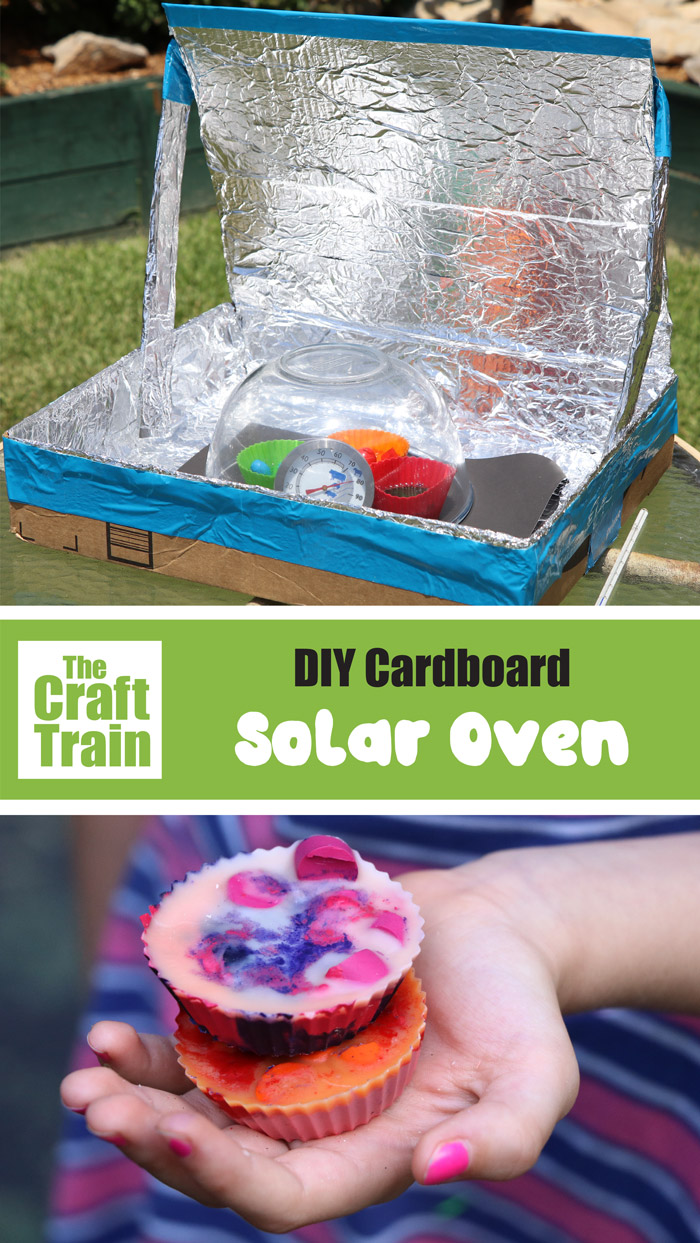

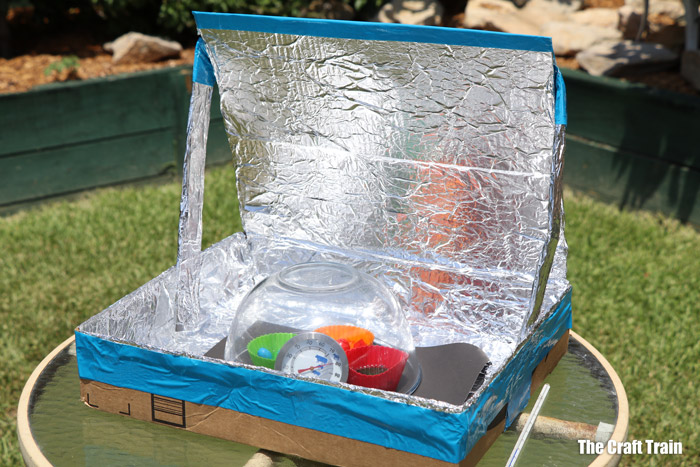
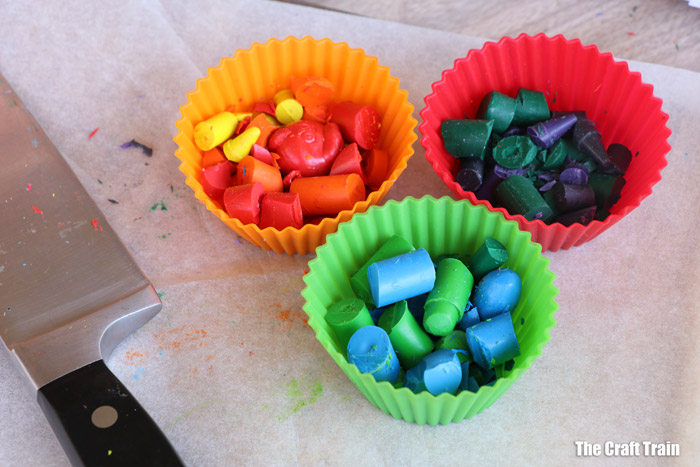
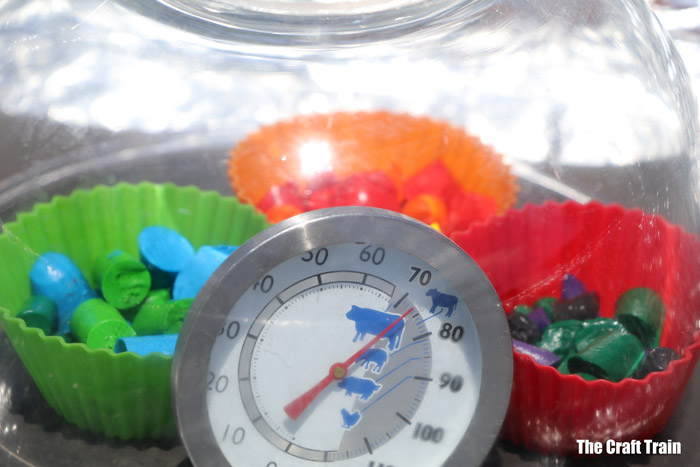
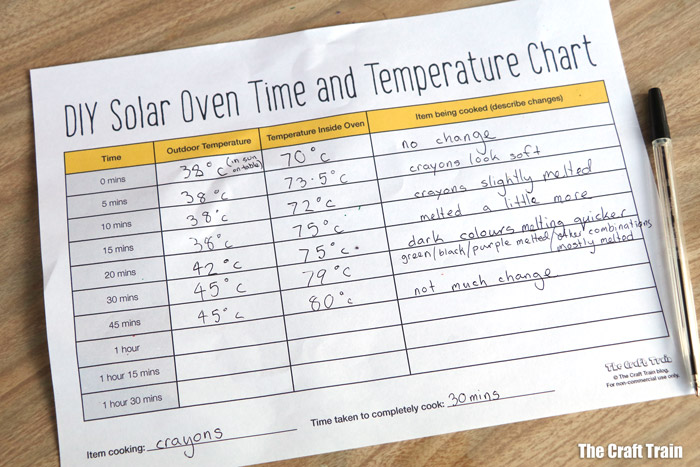
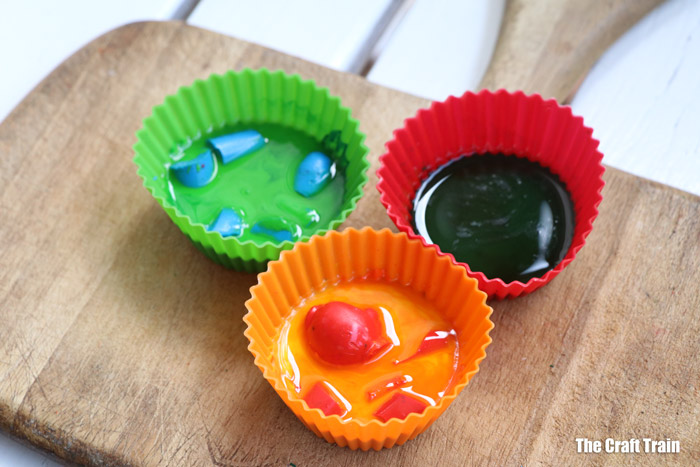
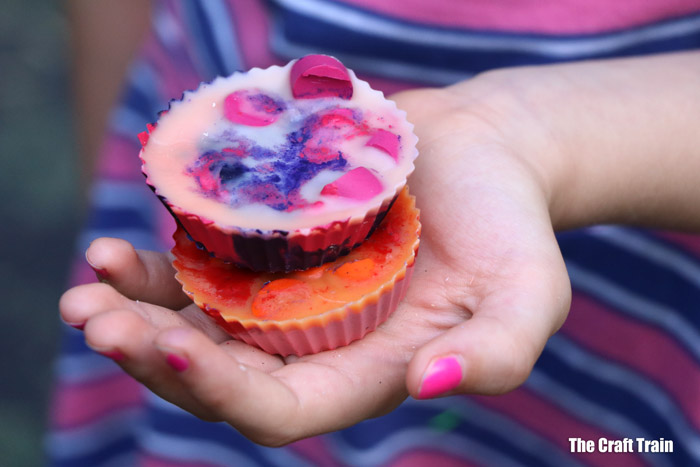
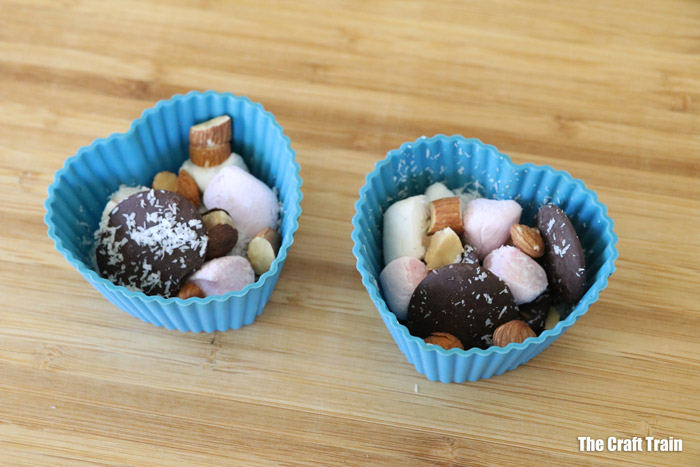





This is a super cool experiment – my boy loves this sort of thing
This is great. Looking forward to giving it a go when the weather warms up.
It’s lots of fun
Just wanted to comment that this oven works equally well in colder weather, if you’re willing to wait. 🙂 We made some beautiful crayons a couple days ago, when it was a balmy 46 degrees F here in Maryland, USA. It took the better part of a day, and we had to move it twice to keep it in the most direct sunlight. But, in the end we got beautiful, fully melted crayons!
Wow, that’s amazing! We’ll have to try it, thanks for sharing 🙂
This looks amazing!
It’s so easy to make 🙂
Wow super stoked to try this out on the weekend boys
Hope you get some lovely hot weather! Have fun
This solar oven is a great Idea and is being used by a middle school STEM class as a optional project. Before I read this article I made a very similar oven but mine stopped at 100 degrees Fahrenheit and it was only able to melt chocolate.
That’s interesting. I wonder what the difference was? The addition of a black piece of paper to absorb the heat made quite a difference to the temperature. If I made this project again I’d actually modify the design to have four flaps (or maybe more) to catch the sun’s rays better from whatever angle it is in the sky.
That was realy a great construction,and i liked it.i also want to do my own that way but the problem is that i don’t know what you guys mean by black sheet of paper i mean what type of paper is black in colour.now if you people enlighten me more on that, then there’s no problem ok so i think i have said enough.pls write back to me with the answers that i need.
Any black construction paper, or failing that a black piece of cardboard or even a black baking tray
I hope this works. This is the end of the year grade.